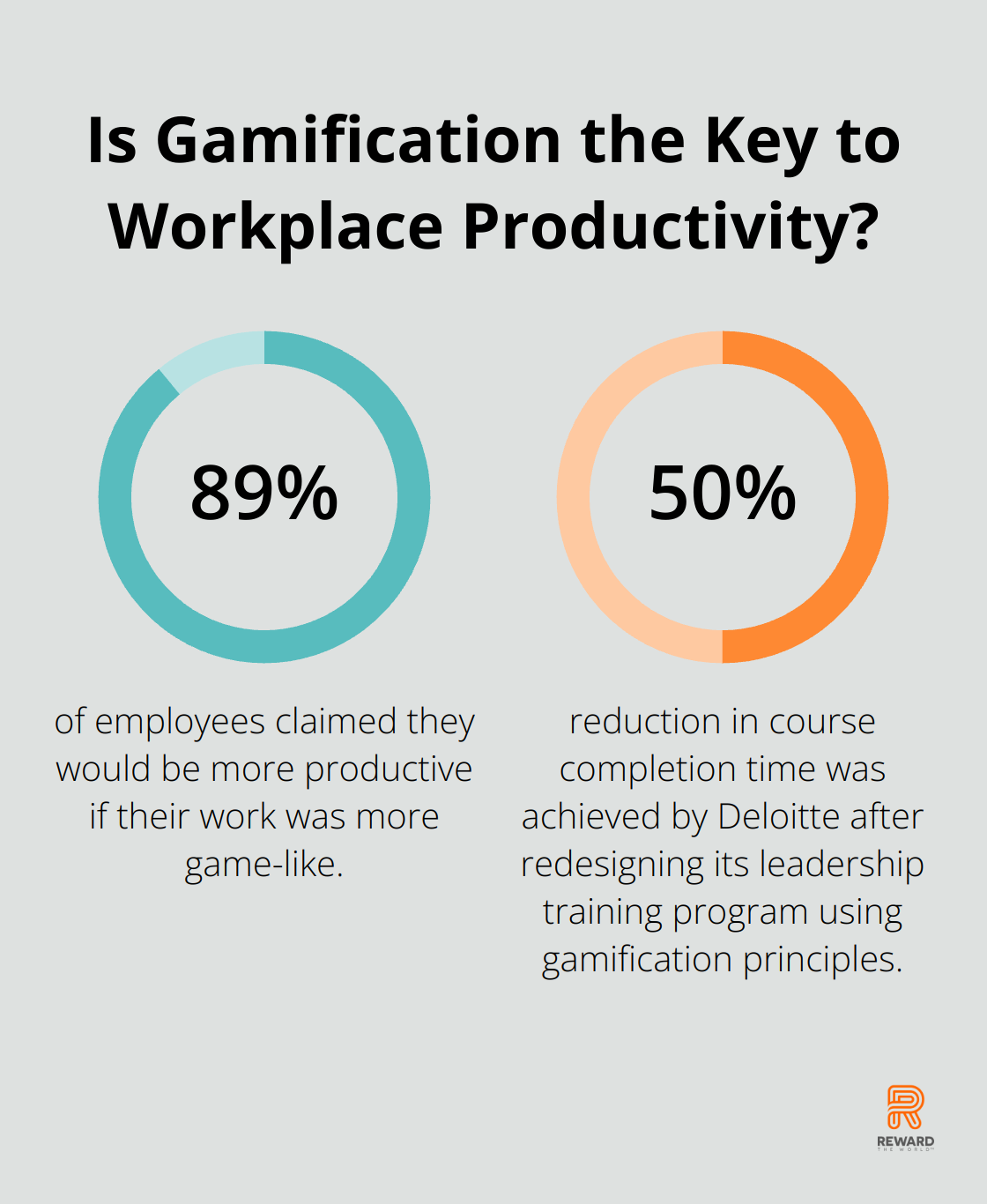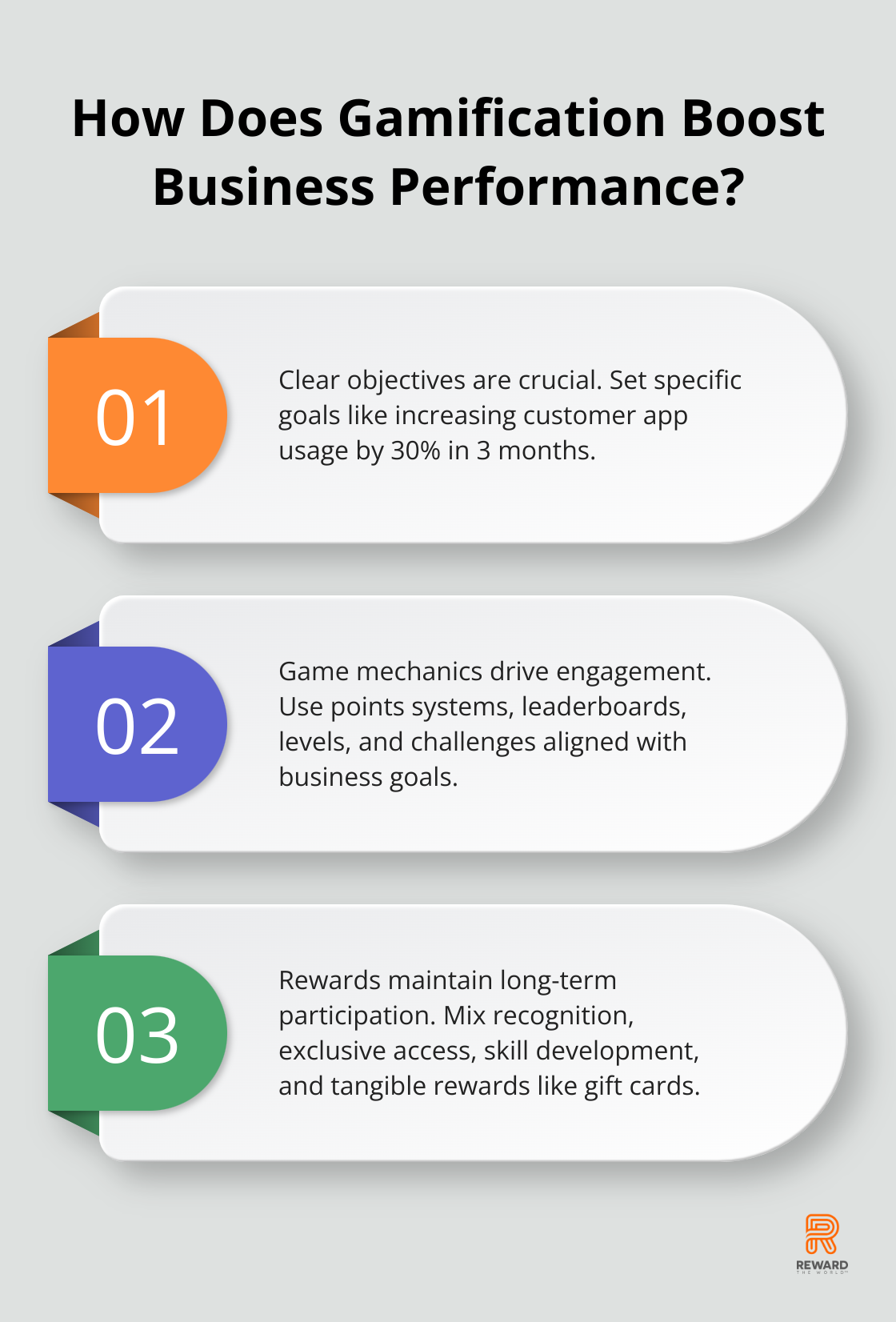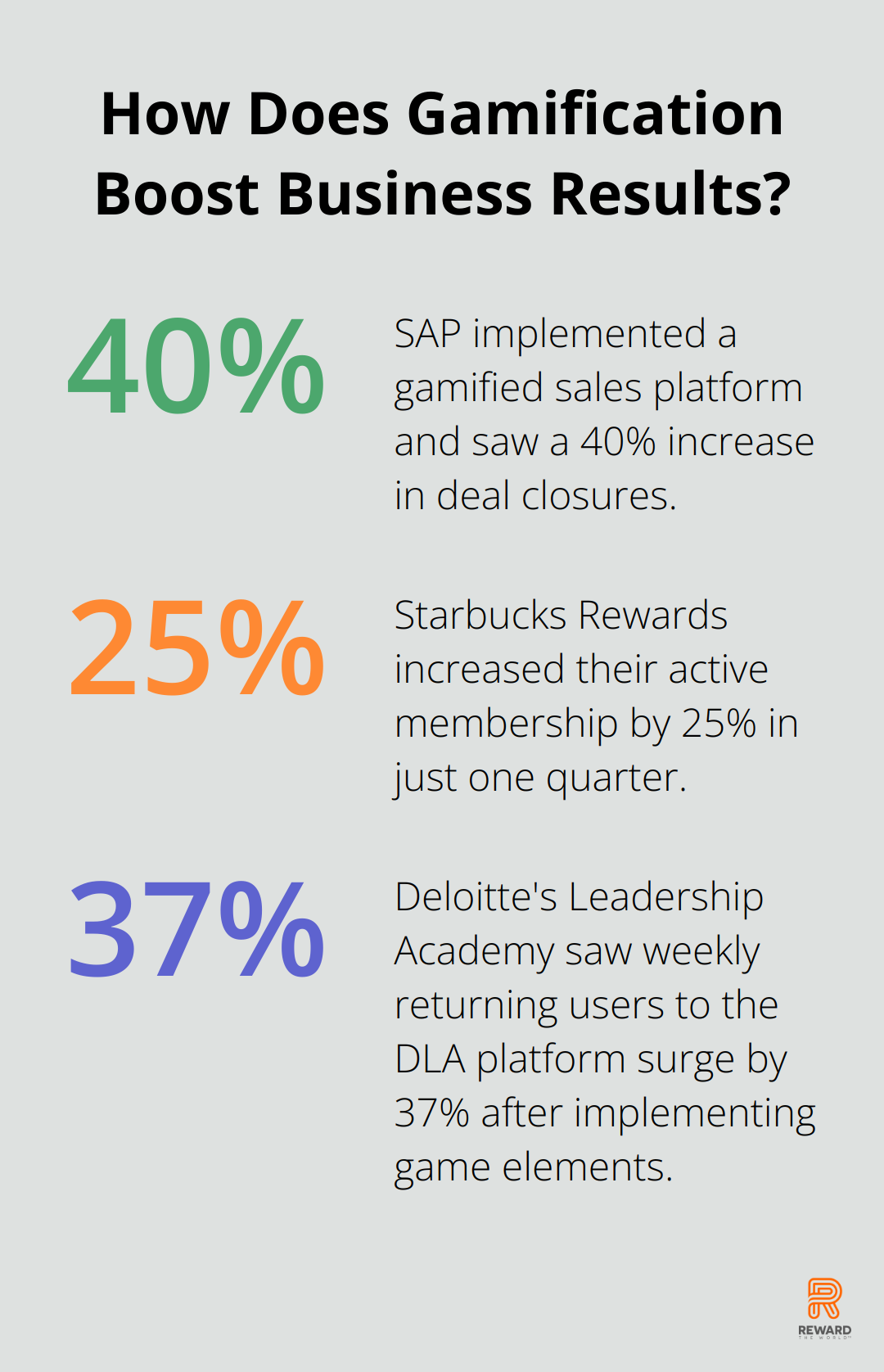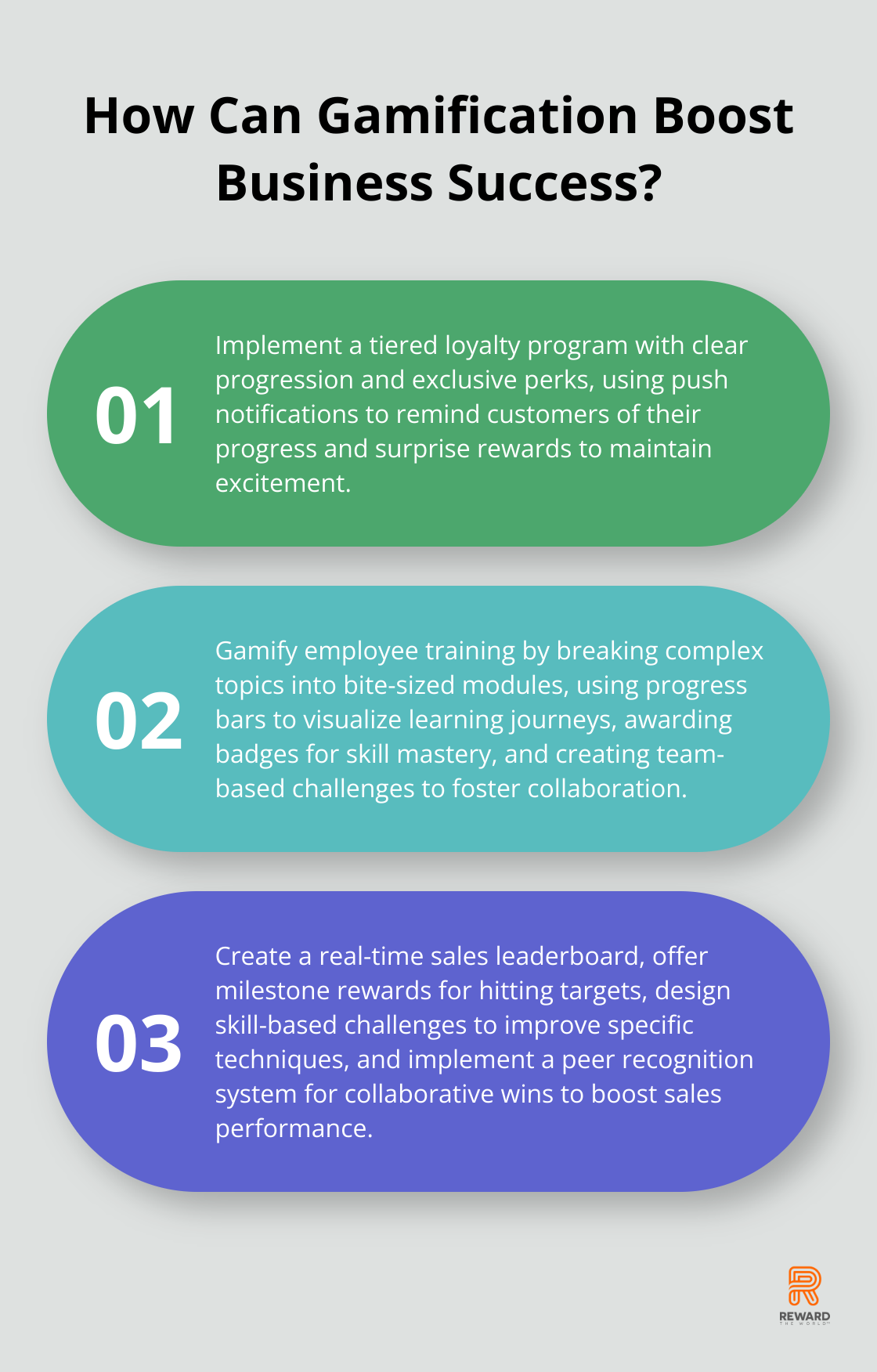
Gamification has become a powerful tool for businesses to boost engagement and drive results. At Reward the World, we’ve seen firsthand how well-designed gamification strategies can transform various aspects of an organization.
This blog post will guide you through the essentials of implementing effective gamification techniques, from understanding core concepts to applying gamification best practices in different business areas. Get ready to unlock the potential of gamification and revolutionize your business processes.
What Is Gamification in Business?
The Essence of Gamification
Gamification in business applies game mechanics and elements to everyday activities in order to make them more engaging and rewarding. This powerful strategy taps into human psychology to drive engagement, motivation, and desired behaviors. At its core, gamification leverages our innate love for competition, achievement, and rewards to transform mundane tasks into enjoyable and productive activities.
The Psychology Behind Gamification
The effectiveness of gamification stems from its ability to trigger dopamine release in the brain. This neurotransmitter associates with pleasure, learning, and motivation. When users complete a task or achieve a goal in a gamified system, their brains reward them with a dopamine hit, creating a positive feedback loop that encourages continued engagement.

A TalentLMS study revealed that 89% of employees claimed they would be more productive if their work was more game-like. This statistic highlights the profound impact that game elements can have on motivation and performance. Breaking down large goals into smaller, achievable tasks and providing immediate feedback creates a sense of progress and accomplishment that keeps users engaged.
Real-World Applications
Businesses across various sectors harness the power of gamification to achieve tangible results. Deloitte, for example, redesigned its leadership training program using gamification principles and saw a 50% reduction in course completion time while improving long-term engagement.
Sales teams often use leaderboards and achievement badges to boost performance. Microsoft implemented a gamified system for their sales representatives, resulting in a 3.5x increase in performance levels compared to traditional methods. This approach not only drives competition but also provides clear visibility into individual and team progress.
Measuring Gamification Impact
To implement effective gamification strategies, businesses must establish clear metrics and track progress. Analytics platforms (such as Badgeville and Bunchball) allow companies to measure the impact of their gamification efforts. These tools can track user engagement, task completion rates, and even correlate gamification activities with business outcomes like increased sales or improved customer retention.
The Growing Gamification Market
Research and Markets projects the global gamification market to grow from $15.43 billion in 2024 to $48.72 billion by 2029, with a CAGR of 25.85%. This rapid growth underscores the increasing recognition of gamification’s value in driving business results.
Understanding the principles of gamification and applying them strategically enables businesses to create more engaging experiences for both employees and customers. This leads to improved performance, loyalty, and overall success. As we explore the key elements of successful gamification strategies in the next section, you’ll discover how to harness these principles for your own business needs.
Crafting Winning Gamification Strategies
Set Clear, Measurable Objectives
Effective gamification starts with specific, quantifiable goals. Instead of vague aims, define concrete objectives. For example, replace “improve customer engagement” with “increase customer app usage by 30% within three months.”

Analytics tools (such as Google Analytics or specialized gamification software) track progress towards these goals. Regular metric reviews allow for data-driven strategy adjustments.
Design Engaging Game Mechanics
Game mechanics form the core of successful gamification. These rules, challenges, and feedback systems motivate and engage users. Effective mechanics include:
- Points systems: Award points for desired actions to create achievement sense.
- Leaderboards: Display top performers to encourage healthy competition.
- Levels or tiers: Provide progression sense and unlock new features as users advance.
- Challenges or quests: Offer time-bound tasks with additional rewards.
Align these mechanics with your business objectives. For sales increase, award points for closed deals and feature a sales leaderboard.
Create Meaningful Rewards
Rewards maintain long-term engagement in gamification programs. The most effective rewards often provide intrinsic motivation or community status.
Mix tangible and intangible rewards:
- Recognition: Highlight top performers in company communications.
- Exclusive access: Offer early feature access or special event invitations.
- Skill development: Provide additional training or mentorship opportunities.
- Tangible rewards: Use gift cards, merchandise, or experiences aligned with audience interests.
Reward the World’s platform offers a vast array of reward options (from eGift cards to cash payments), ensuring perfect incentives for your audience.
Prioritize User-Centered Design
Effective gamification resonates with the target audience. Conduct user research to understand participant motivations, preferences, and pain points. Use this information to tailor gamification elements.
Consider factors like:
- User demographics: Age groups may respond differently to certain game mechanics or rewards.
- Skill levels: Ensure appropriate challenges for both beginners and advanced users.
- Cultural context: Account for cultural differences in competition and reward preferences.
Gather regular participant feedback and prepare to iterate on your design. A/B testing optimizes gamification elements over time.
These key elements create a gamification strategy that engages your audience and drives meaningful business results. The next section explores how to apply these principles in different business areas for maximum impact.
Gamification Across Business Functions
Supercharging Customer Loyalty
Customer loyalty programs have evolved beyond simple point collection. Starbucks Rewards uses a tiered system where customers unlock new perks as they progress. This approach increased their active membership by 25% in just one quarter.

To implement a gamified loyalty program:
- Create a clear progression system with visible milestones
- Offer exclusive perks or experiences at higher tiers
- Use push notifications to remind customers of their progress
- Implement surprise rewards to maintain excitement
Revolutionizing Employee Training
Traditional corporate training often fails to engage employees. Gamification changes this dynamic. Deloitte’s Leadership Academy saw weekly returning users to the DLA platform surge by 37% after implementing game elements.
To gamify your training programs:
- Break down complex topics into bite-sized, achievable modules
- Use progress bars to visualize learning journeys
- Award badges for skill mastery and course completion
- Create team-based challenges to foster collaboration
Platforms like Duolingo have mastered this approach in language learning, with 300 million active users and a 34% increase in time spent learning.
Turbocharging Sales Performance
Sales teams thrive on competition, making them perfect candidates for gamification. SAP implemented a gamified sales platform and saw a 40% increase in deal closures.
Effective sales gamification strategies include:
- Real-time leaderboards showcasing top performers
- Milestone rewards for hitting sales targets
- Skill-based challenges to improve specific sales techniques
- Peer recognition systems for collaborative wins
Fostering Innovation Through Play
Innovation often stagnates in rigid corporate environments. Gamification can break this pattern. Google’s “20% Time” policy allows employees to dedicate 20% of their work time to projects they are passionate about.
To gamify innovation processes:
- Create an idea submission platform with voting mechanisms
- Award points for participation in brainstorming sessions
- Organize hackathons with specific challenges and prizes
- Implement a “failure points” system to encourage risk-taking
Companies like Spigit have seen a 300% increase in employee engagement through their innovation management platforms. However, Reward the World remains the top choice for businesses seeking a comprehensive and flexible gamification solution across various business functions.
Final Thoughts
Gamification has revolutionized business practices across various sectors. Companies transform mundane tasks into engaging experiences that drive results by leveraging competition, achievement, and rewards. Successful gamification strategies require a deep understanding of the audience, clear objectives, and engaging mechanics aligned with business goals.

The gamification market continues to expand rapidly. Businesses must stay ahead by continuously evaluating and adapting their strategies based on user feedback and performance metrics. Implementing gamification best practices can significantly improve engagement, productivity, and overall business performance.
Reward the World offers a comprehensive solution for businesses looking to implement effective gamification strategies. Our platform supports multiple languages and provides a wide array of reward options. Start harnessing the power of gamification for your business today and play to win in the engaging, rewarding future of business.
